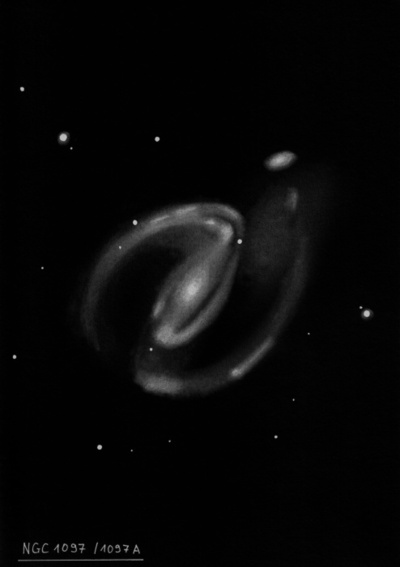
William Herschel discovered NGC 1097 = H V-48 =h2495 on 9 Oct 1790 (sweep 972) and logged "vB; E 75? np to sf; about 8' long. A very bright nucleus confined to a small part about 1' diameter." John Herschel recorded this barred spiral on 18 Nov 1835 from the Cape as "B, L, vmE, pspmbM, 3' long; pos = 151.1?." The next night he logged "B, L, vmE, psvmbM to a pL, R nucleus; 4' long, 40" broad."
Dunlop's D 625 possibly refers to NGC 1097, although his position is too rough to make a positive identification. He found a "round nebula, about 2' dia, very bright at the centre, and very faint from the centre to the margin , almost equally faint from the bright nucleus to the margin. There are two pretty bright small stars following the nebula rather north."
200/250mm - 8" (10/13/81): bright, elongated NW-SE, bright core.
400/500mm - 17.5" (10/17/87): very bright, very large, very elongated NW-SE, very bright core. A companion galaxy NGC 1097A is attached at the NW end.
600/800mm - 30" (10/13/15 - OzSky): NGC 1097 was one of the top highlights of my October 2015 trip to Australia. At 303x; this showpiece barred spiral contains a bright central bar ~4.5'x1.5' NW-SE. The bar is sharply concentrated with an extremely bright, slightly elongated NW-SE core but no distinct stellar nucleus.
A prominent spiral arm is attached on the northwest end of the bar. The arm is relatively thin, well defined and knotty as it curls counterclockwise to the east, dimming out gradually about 3' ENE of center. A large bright knot is close to the northwest end of the bar, just inside the beginning of the arm and close east of a superimposed mag 14.5 star. NED catalogues this region with the multiple designations NGC 1097:[EKS96] 148 and [EKS96] 151 from the 1996 "An Atlas of H II Regions in Nearby Seyfert Galaxies" in ApJS, 105, 93. Roughly halfway along its length is a pair of fairly prominent HII knots. The first is [EKS96] 245, a 12" knot 2.5' NNE of center. Close east is slightly larger [EKS96] 300/304, 2.5' NE of center. The arm then fades as it passes just south of a mag 15 star.
At the southeast end of the bar a delicate, thin spiral arm unfurls counterclockwise towards the northwest. About halfway along its length is a slightly brighter elongated patch extending ~30" in length, with designations [EKS96] 100/105/119 and others. The arm dims out about 3' WSW of center. The arms stretch about 6' tip to tip, giving overall dimensions of perhaps 7'x6'.
The satellite galaxy NGC 1097A is superimposed in the halo on the northwest side, 3.3' from center. It appeared moderately bright, fairly small, elongated 2:1 WNW-ESE, 40"x20".
Notes by Steve Gottlieb